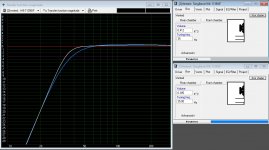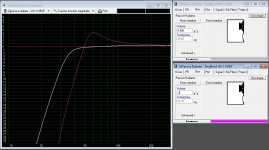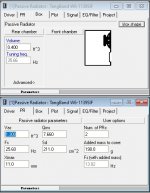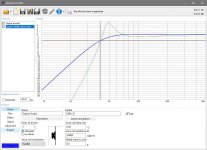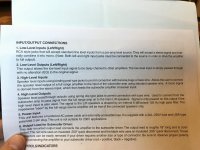Hi all -- I'm new to amp and speaker building. Last winter I built an Amp Camp Amp and two Pensil speakers with Mark Audio Alpair MS11s. I want to add a small subwoofer to fill out the bass response. My listening room is very small and I don't want boomy bass, just more bass. My budget for parts is around $200. (I've got the wood.)
I've decided on the following build, but cannot figure out how to properly use WinISD to calculate box size or the weights for the passive radiators. It has a 6.5" driver and two 8" passive radiators. Can someone help me? Can one of you run the numbers for me, or help me figure out how to properly run the numbers?
Here are the parts:
1 x Tang Band W6-1139SIF 6-1/2" Paper Cone Subwoofer Speaker
2 x Dayton Audio DSA215-PR 8" Designer Series Aluminum Cone Passive Radiator
1 x Dayton Audio SA70 70W Subwoofer Plate Amplifier
Inspiration for this build comes from Soundblab.
Thanks!
I've decided on the following build, but cannot figure out how to properly use WinISD to calculate box size or the weights for the passive radiators. It has a 6.5" driver and two 8" passive radiators. Can someone help me? Can one of you run the numbers for me, or help me figure out how to properly run the numbers?
Here are the parts:
1 x Tang Band W6-1139SIF 6-1/2" Paper Cone Subwoofer Speaker
2 x Dayton Audio DSA215-PR 8" Designer Series Aluminum Cone Passive Radiator
1 x Dayton Audio SA70 70W Subwoofer Plate Amplifier
Inspiration for this build comes from Soundblab.
Thanks!
Hard to get excited about that woofer. I am not a PR fan.
Also consider that 2 woofers makes more sense than a single, and that using 2 drivers / box dramtically reduces box load.
I have some small woofer designs that use the Silver Flute W14. For $200 you can het 4 of them.
Note that a woofer with small drivers like these will not actually extend the bass down much over a Pensil, 2 will help with room modes (which could be severe in a small room), and will help plump up the midbass.
dave
Also consider that 2 woofers makes more sense than a single, and that using 2 drivers / box dramtically reduces box load.
I have some small woofer designs that use the Silver Flute W14. For $200 you can het 4 of them.
Note that a woofer with small drivers like these will not actually extend the bass down much over a Pensil, 2 will help with room modes (which could be severe in a small room), and will help plump up the midbass.
dave
I would also get an other woofer. The Silver Flute is rated very high for it's very cheap US price (sadly not here in Europe as cheap). And Planet10 is wrong, 4 of them cost only 100$ at madisound.
An alternative can be the the Dayton SD270A-88 which is also very cheap and also relative good and will work in a sealed cabinet of 70L and without eq to an F6 (what matters for sealed) of 32Hz. You could use 2 of them in a cabinet double the size and still have money left for a plate amp.
An alternative can be the the Dayton SD270A-88 which is also very cheap and also relative good and will work in a sealed cabinet of 70L and without eq to an F6 (what matters for sealed) of 32Hz. You could use 2 of them in a cabinet double the size and still have money left for a plate amp.
Unfortunately, I don't have the room for two more boxes. If I understand right, you're suggesting two boxes with two subwoofer drivers in each box? Like I said, it's a small living room and full of records and furniture. Could do one box with two drivers if it's not much bigger than a foot square.
I’d suggest that if physical space and budget permits, an external power amp for the subs would be worth considering, and since Dayton has been mentioned in terms of drivers, they have several interesting amp models. I had good success with a pair of AP150s bridged in mono for two small corner located subs, with no appreciable increase in noise floor in that particular application. Of course, if you’re using a processor or surround receiver with LFE channel outputs, you could easily use any available amp stage with sufficient power.
The W14 boxes are small. But an ML-TL (a bit shorter then your Pensils) are also doable.
http://www.planet10-hifi.com/downloads/SF-W14-woofers-120218.pdf
Silver Flute (seems to be) a Madisound housebrand. Why they are cheap in NA, and not so much everywhere else.
dave
http://www.planet10-hifi.com/downloads/SF-W14-woofers-120218.pdf
Silver Flute (seems to be) a Madisound housebrand. Why they are cheap in NA, and not so much everywhere else.
dave
If you have 1 cu.ft. square to work with, I'd consider the DSA215 instead. Make the box 1 cu.ft. in size (basically a cube that's 1ft in each dimension), stuff it, and tune the PRs to 35 Hz. That will easily get down to 35 Hz in-room.
If you want to get lower, in a small room, I'd go with either the 10" or 12" RS Dayton Audio RS driver, sealed, and throw power at it.
If you want to get lower, in a small room, I'd go with either the 10" or 12" RS Dayton Audio RS driver, sealed, and throw power at it.
Last edited:
I was curious what the Tang Band Driver
Mentioned in the OP would actually do.
Did Basic 3rd order (Blue) and 4th order ( White) alignments
Both tuned to around 35 Hz
Basically either use 8.5 liters or 11.3 liters ( .3 or .4 )Cubic feet
F3 response is 38 Hz ( 3rd order) or 33 Hz ( 4th order)
I have enjoyed as well many of the builds from
the youtuber mentioned.
His main objective with using such a small sub.
Is compact systems of course.
But also as well as you can see the
Tang Band Driver can get down to around 35 Hz
but the inductance is also low.
So is easily crossed over much higher than usual
to tie into small fullrange drivers easily.
I do also agree though with some posts
If your system already goes down relatively low.
A good compact sub would be a single 10"
Overall sensitivity will be higher.
So if you plan to use a straight forward 70 watt plate amp.
Could work rather well.

Mentioned in the OP would actually do.
Did Basic 3rd order (Blue) and 4th order ( White) alignments
Both tuned to around 35 Hz
Basically either use 8.5 liters or 11.3 liters ( .3 or .4 )Cubic feet
F3 response is 38 Hz ( 3rd order) or 33 Hz ( 4th order)
I have enjoyed as well many of the builds from
the youtuber mentioned.
His main objective with using such a small sub.
Is compact systems of course.
But also as well as you can see the
Tang Band Driver can get down to around 35 Hz
but the inductance is also low.
So is easily crossed over much higher than usual
to tie into small fullrange drivers easily.
I do also agree though with some posts
If your system already goes down relatively low.
A good compact sub would be a single 10"
Overall sensitivity will be higher.
So if you plan to use a straight forward 70 watt plate amp.
Could work rather well.
Attachments
Hi all -- I'm new to amp and speaker building. Last winter I built an Amp Camp Amp and two Pensil speakers with Mark Audio Alpair MS11s. I want to add a small subwoofer to fill out the bass response. My listening room is very small and I don't want boomy bass, just more bass. My budget for parts is around $200. (I've got the wood.)
I've decided on the following build, but cannot figure out how to properly use WinISD to calculate box size or the weights for the passive radiators. It has a 6.5" driver and two 8" passive radiators. Can someone help me? Can one of you run the numbers for me, or help me figure out how to properly run the numbers?
Here are the parts:
1 x Tang Band W6-1139SIF 6-1/2" Paper Cone Subwoofer Speaker
2 x Dayton Audio DSA215-PR 8" Designer Series Aluminum Cone Passive Radiator
1 x Dayton Audio SA70 70W Subwoofer Plate Amplifier
Inspiration for this build comes from Soundblab.
Thanks!
I did a Model with the Tang Band Driver
and 2 passive radiators mentioned.
Going by my previous models of shooting for
.4 cubic feet ( 11.3 liters ) and tuned to 35 Hz
The pink line shows you what the radiators
would do straight out of the box.
Tuning would be incredible high around 50 Hz.
White line shows the alignment to shoot for
35 Hz
In order to lower tuning of passive radiators
you have to add mass to the radiator.
out of the box they are about 26 Hz
And need to be around 13 to 15 Hz
to yield a box tuning of 35 Hz with 2
radiators.
To achieve 35 Hz tuning
I added 190 grams to each radiator
to achieve the response shown for the white line.
11.3 liter 35 Hz tuning
2 radiators with 190 grams added.
Keep in mind the driver and radiators remove
volume from the enclosure. So your enclosure
needs to be larger than 11.3 liters
I haven't downloaded the driver or radiators
datasheets. So I dont know the volume they displace.
you would need to check and add that.
plus the plate amp and bracing will displace volume.
so to achieve 11.3 liters
the actual enclosure might have to be around
13 to 14 liters.
Just a guess, be better to accurately calculate
Driver, Radiator, Plate amp and Bracing Displacement
Attachments
Hmm, thanks to modern EQ/DSP, [4] of these = $100 + tax/shipping in a 1.0 ft^3 ~0.55 Qtc sealed and EQ'd for best acoustic fit in room yields plenty of high SQ small room [mid, sub] bass down as low as the room goes on 75 W: https://www.newark.com/mcm-audio-select/55-2421/8-high-excursion-woofer-120w-rms/dp/88C7835
Hi all -- Thanks for all the thoughts and info. Thanks especially White Dragon for running some of those numbers for me. It helped me understand how to model the passive radiators in WinISD better. I've been learning more about WinISD the last couple of days, mostly by playing with it, in conjunction with diyaudio&video's speaker box design page. I've decide to go with a bigger sub as some of you suggested and try it in a sealed box with a more powerful plate amp. I had some reward points on amazon so was able to keep the price below $200. I'm going with a more upright box shape to match the pensils -- about 1 cu ft at 20x10x12.5". The subdriver I purchased is the Dayton UM8 Ultimax. The amp is the Dayton SA 100. I tried to model this driver in a sealed box in comparison with my Pensils. It looked like both go down to about 40 hz but as I understand it, the sub will go lower once it's stuffed and in the room. I'm not at all sure I've modeled either correctly. (The Alpair pensil in green in the image below has a big bump around 50 hz.) I figure if the sub isn't low enough I can always add passive radiators to the box. Or build a new box w/ a slot or port.
Attachments
Depending on mechanical ability's of drivers
and overall Vas.
It starts getting more difficult to reach
30 Hz or lower in 1 cubic feet.
The Dayton driver mentioned will get
close to 25 Hz
But would need to be a vented enclosure around 2.6 cubic feet
using just a basic sub C4 alignment.
and overall Vas.
It starts getting more difficult to reach
30 Hz or lower in 1 cubic feet.
The Dayton driver mentioned will get
close to 25 Hz
But would need to be a vented enclosure around 2.6 cubic feet
using just a basic sub C4 alignment.
almost finished my build!
Hi all -- Thanks for the advice earlier. I'm almost finished my subwoofer build. The box is built and the driver and amp are installed and I'm testing it. It sounds amazing. The only thing left is to shellac the case. I have a few questions about low-level input/output vs. high-level input/output.
I'm using a Bellari preamp as a phono stage, an ACA amp running stereo as my main amp. The subamp I got is a Dayton Audio 100W plate amp. The subamp has low-level input/output and high-level input/output. The high-level output has an internal 6 dB/octave 125Hz high pass filter.
I've tried both low-level and high-level options. The low-level is louder (needs less gain) and sounds good, although I noticed some issues with synchronization and my main speakers. The high-level needs to have the gain set higher but seems to sync better. Lots of people online seem to recommend low-level input since it's line-level input, although I think my system sounds better with high-level.
As a noob, I'm trying to understand better how the high-pass filter is effecting the sound. Am I right that the high pass filter on the high-level input means that any sounds below 125Hz are being filtered out of my main speakers? Which means that they're working less hard and that there would less issues syncing sounds below 125Hz w/ the subamp? If that's the case, then why wouldn't I set the frequency knob (the crossover) on the subamp around 125Hz instead of the recommended 60-100Hz? Around 80Hz seems to sound best to my ears. Why do people like the low-level/line-level inputs better? I'll obviously go with what sounds best to me, but I'm trying to learn all these nuances to better understand how speaker building and hi-fi systems really work.
Also -- I was an apostate and didn't brace the box since I used birch ply. Seems fine. No rattles or weird box noise. And I'm debating stuffing. Although I used it on my pensils (my main speakers, which I also didn't brace and are fine) as recommended, it seems that a subwoofer box built to the optimum size doesn't need it?
FYI, I'm only using this to listen to records -- to home theater etc. Just a pure 2.1 system. See attached pics.
Hi all -- Thanks for the advice earlier. I'm almost finished my subwoofer build. The box is built and the driver and amp are installed and I'm testing it. It sounds amazing. The only thing left is to shellac the case. I have a few questions about low-level input/output vs. high-level input/output.
I'm using a Bellari preamp as a phono stage, an ACA amp running stereo as my main amp. The subamp I got is a Dayton Audio 100W plate amp. The subamp has low-level input/output and high-level input/output. The high-level output has an internal 6 dB/octave 125Hz high pass filter.
I've tried both low-level and high-level options. The low-level is louder (needs less gain) and sounds good, although I noticed some issues with synchronization and my main speakers. The high-level needs to have the gain set higher but seems to sync better. Lots of people online seem to recommend low-level input since it's line-level input, although I think my system sounds better with high-level.
As a noob, I'm trying to understand better how the high-pass filter is effecting the sound. Am I right that the high pass filter on the high-level input means that any sounds below 125Hz are being filtered out of my main speakers? Which means that they're working less hard and that there would less issues syncing sounds below 125Hz w/ the subamp? If that's the case, then why wouldn't I set the frequency knob (the crossover) on the subamp around 125Hz instead of the recommended 60-100Hz? Around 80Hz seems to sound best to my ears. Why do people like the low-level/line-level inputs better? I'll obviously go with what sounds best to me, but I'm trying to learn all these nuances to better understand how speaker building and hi-fi systems really work.
Also -- I was an apostate and didn't brace the box since I used birch ply. Seems fine. No rattles or weird box noise. And I'm debating stuffing. Although I used it on my pensils (my main speakers, which I also didn't brace and are fine) as recommended, it seems that a subwoofer box built to the optimum size doesn't need it?
FYI, I'm only using this to listen to records -- to home theater etc. Just a pure 2.1 system. See attached pics.
Attachments
The high level input/ output.
seems to be a speaker level input and output.
And includes a very simple 6 dB highpass filter.
Yes it is removing some of the bass so the main speakers wont distort so quickly
from bass signals. And lets the sub carry that bandwidth.
That would be the ideal setup to highpass the main speakers
to improve there performance and make it less likely for cancelation
or phase problems.
Some amps of course provide power for the main speakers and sub.
and there is a active filter for both those amps.
In this case it sounds like they include a passive crossover/ highpass filter
in the unit as a added feature. For the main speakers.
Since its only a single amp for a sub.
It would be the same thing as you using a passive crossover for your main speakers
to highpass a little bass out of the signal. but instead of you building or buying a cross over board.
its already built into the unit.
Basically what your doing, you amp output goes "in" which connects to the filter.
then the output is the filter.
And yes since you know its a very shallow 6 dB 125 Hz highpass.
Its likely the sub crossover could sound best around 100 to 120 Hz so you dont leave
a " hole" in the response.
But again whatever sounds good to your ear.
80 Hz is what I usually use for subs.
Depends on the sub as well, sometimes there really is no detail above 80 Hz
Main issue could be if 125 Hz is to high for the mains and some detail is being lost.
Its likely why they used such a soft 6 dB filter slope.
seems to be a speaker level input and output.
And includes a very simple 6 dB highpass filter.
Yes it is removing some of the bass so the main speakers wont distort so quickly
from bass signals. And lets the sub carry that bandwidth.
That would be the ideal setup to highpass the main speakers
to improve there performance and make it less likely for cancelation
or phase problems.
Some amps of course provide power for the main speakers and sub.
and there is a active filter for both those amps.
In this case it sounds like they include a passive crossover/ highpass filter
in the unit as a added feature. For the main speakers.
Since its only a single amp for a sub.
It would be the same thing as you using a passive crossover for your main speakers
to highpass a little bass out of the signal. but instead of you building or buying a cross over board.
its already built into the unit.
Basically what your doing, you amp output goes "in" which connects to the filter.
then the output is the filter.
And yes since you know its a very shallow 6 dB 125 Hz highpass.
Its likely the sub crossover could sound best around 100 to 120 Hz so you dont leave
a " hole" in the response.
But again whatever sounds good to your ear.
80 Hz is what I usually use for subs.
Depends on the sub as well, sometimes there really is no detail above 80 Hz
Main issue could be if 125 Hz is to high for the mains and some detail is being lost.
Its likely why they used such a soft 6 dB filter slope.
Last edited:
- Home
- Loudspeakers
- Subwoofers
- help with calculations for a subwoofer build
